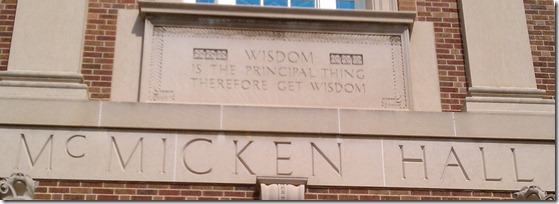Recently, Seth Godin posted in his blog a piece titled Who is your customer? Thinking about higher education customers, Seth’s post motivated me to write about something that I’ve shared with a few leaders. Some immediately get it, others immediately dismiss it, failing to introspectively look deep enough to understand the difference. That is, the customer-centric mindset has a pervasive culture to do things “FOR” customers, not an attitude that they are there to do things “TO” customers. Higher education can learn from Seth’s new rules.
Seth Godin’s Customer Rules
Seth’s post identifies two rules: 1) you can build business on great customer service, and 2) great customer service requires you treat customers differently (paraphrased).
So often we can observe decision making failure where a company has a strategy to do something TO customers, and call that “value.” This mindset is precisely opposite what I see in what Seth wrote. In order build a great business, there must be a natural culture that focuses on understanding what the organization/institution can uniquely do FOR each and ALL customers, often uniquely, in order that the customer truly receives value from every angle of perception.
Seth’s uses the example of Zappos vs. Nike. Clearly, Zappos’ legendary customer-centricity is well known. While Nike is about delivering a homogenized product to everyone in the same way. Other’s are learning the FOR vs. TO approach. Some will evolve and prosper. Others have such deeply engrained antibodies in their culture that they are likely to die in the process.
Higher Education
One to watch out for is Higher Education. While many large public and private ivy-league institutions are defending their status behind a message of “invest in yourself” the student (customer) is perceiving this message in the following way. “My tuition goes to fund someone else’s ‘research’ but my individual success for the money I spend is completely untethered to the experience value behind message.”
Some Institutions See Students As Customers
Meanwhile, some public state institutions, U of MN for example, have reinvented the entire student experience, engaging students and their parents with Zappos-level attention and service. Building a value proposition that focuses on what the institution will do FOR students (customers) in terms of student success for everyone, including a 4 year graduation commitment in the form of a guarantee. U of MN sees the value to students and society in creating more educated students overall.
Not enough state institutions relying on taxpayer support are having this epiphany or are making the shift from “TO” to “FOR”. This shift is in transition now – some institutions will make it, others will fail, and still others are hoping for a state money bailout. Consider that The Ohio State University in their new freshman orientation tour last year started out the presentation with “we are solvent” and not dependent on the state of OH for money – then went on to say how they were focused on EVERY students success in what they do FOR students (customers). True or not, it’s a clear mindset there.
Public and Private Can Learn From For Profit
Higher education has another revolution coming. Online, and for-profit universities have the interest, wherewithal and business-centric DNA to know that they have no safety-net, and must do something FOR customers by delivering a competitive learning product that DELIGHTS customers (students), and their message is all about career advancement measured in meaningful ROI metrics. Even with the University of Phoenix recruiting fumbles of recent history, this is a force in higher education that is focused on doing things FOR it’s customers. They have to – or they will fail. Walden, Embry Riddle, and other universities are seeing this.
Performance Is Still Measured
I’m not suggesting that this affects how performance is measured or how grades are given. However, it is a change in attitude from: “What can we do to lobby more sources of revenue and extract endowments from lucky alumni to keep our old traditional institutionalized ways going?” To: “How can we maximize our programs, curriculum, and academic approaches to ensure that every student is successful at learning and growing – and eventually being a productive contributor in the workforce?” Clearly, the former is introspective, and the latter is customer-centric. I’ll even suggest that the latter is more conducive to producing profound research, new invention, breakthrough innovation, and significant contribution to the GDP of the nation. We all know that will accelerate economic growth.
Benefit to Society and Economies
Producing productive, educated members of society is critical. Traditionally, higher education separated the ditch diggers from the doctors and lawyers. Institutions did this by doing something TO students as an approach of separating below average from exceptional, leaving below average behind, using average to fund the institution, and the elite to bring prestige.
In our competitive digital economy, we need EVERY student learning, and contributing. Separating them achieves no higher order objective. Spend the time, build the programs, do something FOR EVERY student by helping, encouraging, and teaching them to be successful. Traditional institutional approaches of yester-decades won’t do that for the maximum number of students, nor is the old way “customer-centric.”
More educated people is better, when it comes to having educated people coming out of our institutions of higher education. Customer (student) centricity will achieve that.
Epilogue
There will be readers of this that say “he doesn’t understand the real nature of the internal situation that higher education is dealing with.” Or, that “education is something ‘special’ or ‘unique’ and those customer-centricity rules about product-service and customer-delight don’t apply.”
I preemptively respond that such an attitude is indicative of blindness or at the least, not thinking of the customer. Moreover, if there is an exchange of payment for value, then, by definition, it is a business. You can call it something else, but at its core, it’s a business.
The “situation” from the institution’s internal perspective is not a formula for decision-making nor a sustainable factor in providing a great innovative education product and outstanding service. Nor will it sustainably produce delighted customers (students).
Just ask Tony Hsieh at Zappos, Jeff Bezos at Amazon, or Seth Godin. I think I can guess their answer. What do you think?












In a time where Higher Education’s value is increasingly called into question Andrew, I think your piece targets their approach toward value creation dead-center.
One of the most immediate needs traditional ‘4-year’ universities need to address for new students: How do you convince an 18 year-old the magnitude of their deciding to go $125,000-250,000 in debt–and for what? A degree obsolete before they finish it?
Good piece.